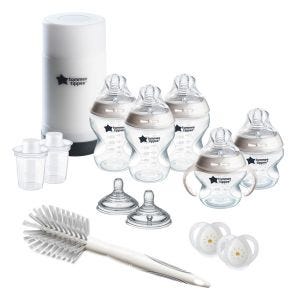As powdered baby formula is not sterile, hygiene and protecting your little one's immune system should always be at the forefront of your mind when you're making a bottle of formula.
To reduce the risk of infection, every piece of feeding equipment you use should be thoroughly cleaned and sterilized before every feed. This should be done until your little one is 12 months old. You should also always follow the instructions on the formula's packaging carefully when you make up a bottle feed.
Making a baby bottle: What you'll need
Formula feeding must-haves
- A clean and sterile work surface.
- A clean water supply: Cooled, boiled tap water is the safest, but it's a good idea to speak to your paediatrician if you're feeling unsure about whether you should boil the water before making your baby's bottle.
- Your choice of first infant formula or ready-to-feed liquid formula (if you're going to give your baby ready-to-feed liquid formula, you only need to wash your hands thoroughly, swirl the bottle thoroughly, attach a nipple).
- At least six bottles with caps in various sizes.
- At least six nipples in a range of flow rates.
- A bottle and nipple brush.
- Sterilizing equipment.
- Tongs to pick up your sterilized feeding equipment.
- Muslin cloths and bibs.
Formula feeding nice-to-haves
How to make a formula bottle at home: Step-by-step guide
- Thoroughly wash your hands and make sure that the surface you're going to prepare the bottle on is clean and disinfected.
- Stand your sterilized bottle on the clean surface.
- Read the instructions on the formula's label carefully. This will let you know exactly how much water and powder you need.
- Pour the required amount of water into your bottle, and then double check to make sure the volume of water is correct.
- Once the water is added, follow the manufacturers' guidelines, and add the exact amount of formula powder you need to the bottle using the scoop provided. Adding too much powder could cause your baby to become constipated or dehydrated. Using too little powder can potentially lead to your baby not getting the nourishment they need.
- Reseal the formula's packaging to protect it from germs and moisture.
- Screw on the bottle ring and nipple securely, and then pop the cap on the nipple.
- Next, swirl the bottle so all the formula dissolves and there are no clumps visible.
- Once mixed, you can warm the bottle of formula up by submerging it (with the cap still on) in warm water or by using an electric bottle warmer.
- The formula should be body temperature and feel lukewarm, but not hot. It's a good idea to test the temperature by pouring a few small drops onto the inside of your wrist first. Then, you're ready to feed!
- If there's any formula left over after your baby's finished feeding, you should dispose of it within two hours.
- Thoroughly clean the bottle and nipple, and pop them back in your sterilizer, so they're ready for baby's next feed.
How to prepare a baby's bottle while away from home
Now that we've covered how to make a bottle of baby formula at home, let's tackle how to prepare a feed for your little one when you're on the go.
If you need to feed your baby when you're away from home, you'll need:
- The correct amount of formula powder measured out and stored in a clean and dry container.
- A clean flask of water that's only used for your baby.
- An empty sterilized bottle and nipple with a protective cap on.
- A bottle warmer.
If you're not able to follow the above steps or need to take a feed to your baby's nursery, you can make up their bottle at home, cool it, and pop it alongside an ice pack in a cool bag. Formula stored:
- in the refrigerator must be used in 24 hours
- with an ice pack in a cool bag must be used in four hours
- at room temperature must be used in two hours.
Alternatively, you can use a carton of ready-to-feed liquid formula to feed your baby when away from home. Liquid formula milk is sterile until opened. However, all feeding equipment (including bottles and nipples) will still need sterilizing. Once it's been opened, any liquid infant formula that is unused should be stored on the top shelf at the back of the fridge, for no longer than 24 hours.
Formula bottle preparation: Dos and don'ts
